| Location | Date ‘17 | # of Paper filers | # of E-filers | # of Participants |
|---|---|---|---|---|
| Kitchener/Waterloo, ON | October 16 | 4 | 12 | 16 |
| Montreal, QC | October 17 | 7 | 12 | 19 |
| Fredericton, NB* | October 18 | - | 12 | 13 |
| Vancouver, BC | October 19 | 5 | 14 | 19 |
*1 participant in Fredericton did not know whether they submitted via paper or electronic
Results from qualitative research are directional only and are not statistically projectable to the overall population.
NRG was responsible for the recruitment of individuals to participate in the focus group sessions. The sample frame consisted of records sourced from the CRA, who were individuals who might qualify to use the new File My Return service.
Individuals were qualified for the study using a screening instrument developed jointly by NRG and the CRA. Specifically, these are individuals who indicated having no income, or their only income was from one or more of the following sources (OAS, CPP, QPP, EI, workers’ compensation, social assistance payments and net federal supplements). None of the participants had employment income (including self-employment). This instrument can be found in the Appendices attached to this report.
Participants were informed during the recruitment that the research was sponsored by the Government of Canada. In addition, during recruitment, verification and confirmation/reminder stages, participants were informed the sessions are being audio-taped for research purposes. All attending participants provided oral and written consent to this fact.
Each group lasted approximately 1.5 to 2 hours and was moderated by a trained research professional. Andrew Enns with NRG moderated all the groups except for those held in Montreal. John Patterson of Patterson, Langlois Consultants moderated the Montreal groups, which were conducted in French.
The groups were moderated using a prepared discussion guide developed jointly by NRG and the CRA, which can be found in the Appendices attached to this report.
All participants received a $90 honorarium in appreciation for their feedback.
As is standard with qualitative research done on behalf of the Government of Canada, the following conditions were also applied for all participants:
- They had not participated in a discussion group within the last six months;
- They had not attended, in the past two years, a focus group discussion or in-depth interview on issues related to the topic at hand;
- They had not attended three or more focus groups or in-depth interviews in the past five years;
- At least one third of the participants recruited for each group must never have attended a group discussion or in-depth interview before;
- They had a sufficient command of English (or French for the Montreal groups) to fully participate in the focus group sessions; and,
- They or their family are not employed in any of the following:
- - A research firm
- - A magazine or newspaper
- - An advertising agency
- - A political party
- - A radio or television station
- - A public relations company
- - Federal government
As with all research conducted by NRG, contact information was kept entirely confidential and all information that could allow for the identification of participants was removed from the data, in accordance with the Privacy Act of Canada.
Appendix B: Qualitative Screener
B.1 English Version
CLIENT INTRO
Hello, my name is __________________. I'm calling from NRG Research Group, a national opinion research firm. We’re organizing a focus group on behalf of the Government of Canada. Focus Groups are in-depth research discussions involving a small number of people that are brought together to talk about different topics. These groups will look for feedback on letters about a new service that will be offered to some Canadians. About twelve people will be taking part, all of them randomly recruited by telephone just like you.
INTRO
Participation is voluntary and all your answers will be kept confidential and will be used for research purposes only. We are simply interested in hearing your opinions – no attempt will be made to sell you anything. The format is a “round table” discussion lead by a research professional. An audio recording of the session will be produced for research purposes. The recording will be used only by the research professional to assist in preparing a report on the research findings and will be destroyed once the report is completed.
IF RESPONDENT ASKS HOW WE RECEIVED THEIR PHONE NUMBER, SAY:
[IF CRA CONTACT/VERIFICATION NEEDED: Krista Holmes, Senior Public Affairs Advisor, 613-617-1343]
[IF ASKED WHAT DEPARTMENT SPONSORS THE STUDY: This research is sponsored by the Canada Revenue Agency. Note that your participation will remain completely confidential and that it will not affect your dealings with the Government of Canada, including the Canada Revenue Agency, in any way.]
ADDITIONAL INFO FOR THE INTERVIEWER IF RESPONDENT ASKS FOR INFORMATION ON HOW THE RECRUITER SELECTED THEM:
You were randomly selected from a large list of phone numbers provided by the Canada Revenue Agency solely to assist in recruiting for these focus groups. We do not tell the Canada Revenue Agency who we have contacted from their large list. The list will be deleted immediately following the research. The list provided to us contains only the information required to assist with recruiting participants for the discussion sessions.
SCREENER QUESTIONS:
May I ask you a few questions?
- Yes [CONTINUE]
- No [SCHEDULE A CALL BACK/ THANK & TERMINATE]
1. Are you a Canadian citizen at least 18 years old who normally resides in the [KITCHENER-WATERLOO] Area?
- Yes [CONTINUE]
- No [THANK & TERMINATE]
2. Please tell me if you or any member of your immediate family works in or has retired from [CHECK ALL THAT APPLY]:
- Market Research or Marketing
- Public Relations or Media (TV, Print)
- Advertising and communications
- Accounting or Tax Preparation
- Political Party
- Federal or Provincial Government Department
[THANK & TERMINATE IF YES TO ANY OF THE ABOVE]
3. Would you be available to attend a discussion group Monday, October 16th, 2017? It will last no more than two hours and at the conclusion of the group you be compensated for your time with a $90 cash honorarium?
- Yes [CONTINUE]
- No [THANK & TERMINATE]
4. Gender [BY OBSERVATION ONLY; DO NOT READ. RECRUIT A MIX]
- Male
- Female
5. And which of the following age groups are you currently in? Are you ....READ LIST (AIM FOR A MIX OF AGES)
- Under 18 years [THANK & TERMINATE]
- 18 - 24 years
- 25 - 34 years
- 35 - 44 years
- 45 - 54 years
- 55 – 64 years
- 65 years and or older [THANK & TERMINATE]
6. Can you please tell me which of the following best describes your situation since January 1, 2017 [DO NOT READ LIST]
- Working full-time [THANK & TERMINATE]
- Working part-time [THANK & TERMINATE]
- Self-employed [THANK & TERMINATE]
- Unemployed but looking for work [CONTINUE]
- Not working [CONTINUE]
- Unable to work [CONTINUE]
- Student [THANK & TERMINATE]
7. I’m going to read you a list of possible income sources that you may receive. Please tell me if any of your personal income is made up by them. Do you receive income from…[INSERT SELECT ALL THAT APPLY]
- OAS – Old Age Security
- CPP – Canada Pension Plan
- QPP – Quebec Pension Plan
- EI - Employment Insurance
- Worker’s Compensation
- Social Assistance Payments
- Net Federal Supplements
- I have no income
- Don’t know [DO NOT READ][THANK & TERMINIATE]
- Refused [THANK & TERMINATE]
8. Do you have any other types of income not listed above?
- Yes [THANK AND TERMINATE]
- No [CONTINUE]
9. Did you complete your taxes on your own or receive help from someone else? [USING A TAX SOFTWARE DOES NOT COUNT AS RECEIVING HELP]
- Completed on your own
- Received help – Friend/Family member
- Received help – Tax preparation service/accountant
- Don’t know
10. Do you know if your taxes were filed electronically or by paper? Typically, when you file your taxes, do you file online or by paper submission?
- Paper Submission [QUALIFIES FOR GROUP 1]
- Electronically [QUALIFIES FOR GROUP 2]
- Don’t know [DO NOT READ][If ‘Received help – Tax preparation service/accountant/volunteer service, QUALIFIES FOR GROUP 2]
11. What is the highest level of education you have attained? Is it…
- Less than high school
- High school graduate
- Some college/Technical school
- Completed college/Tech. school
- Some University
- Completed University
- Other
- Don’t Know/Refused [THANK & TERMINATE]
12. Have you ever attended a focus group discussion which was arranged in advance and for which you received a sum of money for participating?
- Yes [CONTINUE – MAX 6 PER GROUP]
- No [SKIP TO INVITATION OR STANDBY]
13. [IF Q12=YES, ASK] When was the last time you attended a group?
14. [IF Q12=YES, ASK] How many groups have you attended in the past 5 years?
15. [IF Q12=YES, ASK ] What was the topic of the most recent focus group you attended?
[THANK & TERMINATE IF TOPIC TAXATION/GOVERNMENT RELATED]
TERMINATE IF RESPONDENT OFFERS ANY REASON SUCH AS SIGHT OR HEARING PROBLEM, A WRITTEN OR VERBAL LANGUAGE PROBLEM, A CONCERN WITH NOT BEING ABLE TO COMMUNICATE EFFECTIVELY OR IF YOU HAVE A CONCERN)
[INV1] As I mentioned earlier, the group discussion will take place, Monday, October 16th, 2017 at 5:30pm/7:30pm for no more than 2 hours. Would you be willing to attend?
- Yes [CONTINUE]
- No [THANK & TERMINATE]
[INV2] The group discussion will be audio recorded for research purposes only. Please be assured your comments and responses are strictly confidential. Are you comfortable with the discussion being audio recorded?
- Yes [CONTINUE]
- No [THANK & TERMINATE]
[INV3]The discussion will also take place in a focus group or meeting room that will be equipped with a one-way mirror or audio set-up for observation. There may or may not be a government observer but they will not know your full name. The purpose of them observing is to hear your thoughts and opinions and take notes without disturbing the group discussion. Would this be a problem for you?
- Yes [THANK & TERMINATE]
- No [CONTINUE]
[INV4]Participants may be asked to read materials and write out responses on their own during the focus group. How comfortable are you in taking part in these activities in (English/French) without assistance if these were part of the focus group? Are you…?
- Very comfortable [CONTINUE]
- Comfortable [CONTINUE]
- Not very comfortable [CONTINUE, BUT NOTE FOR GROUPS AND ACCOMMODATE]
- Not at all comfortable [THANK & TERMINATE]
If you require reading glasses, please bring them with you.
[INV5] Since participants in focus groups are asked to express their thoughts and opinions freely in an informal setting with others, we’d like to know how comfortable you are with such an exercise. Would you say you are…?
- Very comfortable [CONTINUE]
- Comfortable [CONTINUE]
- Not very comfortable [THANK & TERMINATE]
- Not at all comfortable [THANK & TERMINATE]
Do you have a pen handy so that I can give you the address where the group will be held. It will be held at :
B.2 Version Française
INTRO DU CLIENT
Bonjour, je m’appelle _______________. J’appelle de NRG Research Group, une société de recherche sur l’opinion nationale. Nous organisons des groupes de discussion au nom du gouvernement du Canada. Par groupes de discussions, on entend des discussions en détail sur la recherche auxquelles participent un petit nombre de personnes réunies afin de parler de divers sujets. L’objectif de ces groupes sera d’obtenir des commentaires sur les lettres à propos d’un nouveau service qui sera offert à certains Canadiens. Environ douze participants seront recrutés, lesquels auront tous été recrutés par téléphone de façon aléatoire comme vous.
INTRODUCTION
La participation est volontaire et toutes vos réponses seront traitées de façon confidentielle et seront utilisées aux fins de recherche seulement. Nous souhaitons seulement connaître vos opinions – nous n’essayerons pas de vous vendre quoi que ce soit. Le format sera une discussion en « table ronde » animée par un professionnel de la recherche. L’ARC produira un enregistrement audio ou vidéo de la séance de groupe à des fins de recherche. Seul le chercheur utilisera cet enregistrement afin de rédiger un rapport sur les résultats de recherche. L’enregistrement sera détruit dès que ce rapport aura été rédigé.
SI LE RÉPONDANT VOUS DEMANDE COMMENT NOUS AVONS OBTENU SON NUMÉRO DE TÉLÉPHONE, DITES :
[SI UNE COMMUNICATION/VÉRIFICATION DE L’ARC EST REQUISE : Krista Holmes, conseillère principale en affaires publiques, 613-617-1343]
[SI LE RÉPONDANT DEMANDE QUEL MINISTÈRE PARRAINE L’ÉTUDE : Cette recherche est parrainée par l’Agence du revenu du Canada. Veuillez noter que votre participation demeurera strictement confidentielle et que le fait de participer à cette recherche n’a aucune incidence sur vos relations avec le gouvernement du Canada, y compris l’Agence du revenu du Canada.]
RENSEIGNEMENTS SUPPLÉMENTAIRES POUR L’INTERVIEWEUR SI LE RÉPONDANT DEMANDE DE L’INFORMATION SUR LA MÉTHODE UTILISÉE PAR LE RECRUTEUR POUR LE SÉLECTIONNER :
Vous avez été sélectionné de façon aléatoire à partir d’une longue liste de numéros de téléphone fournie par l’Agence du revenu du Canada dans le but unique d’aider à recruter pour ces groupes de discussion. Nous n’avisons pas l’Agence du revenu du Canada des personnes sur la longue liste avec lesquelles nous avons communiqué. La liste sera supprimée immédiatement après la recherche. La liste qui nous a été fournie contient seulement les renseignements nécessaires pour aider à recruter des participants pour les séances de discussion.
QUESTIONS DU SÉLECTIONNEUR :
Puis-je vous poser quelques questions ?
- Oui [CONTINUEZ]
- Non [[FIXEZ UNE DATE DE RAPPEL/REMERCIEZ LE RÉPONDANT ET METTEZ FIN À L’APPEL]
1. Êtes-vous un citoyen canadien d’au moins 18 ans qui réside normalement dans la région de [MONTREAL]
- Oui [CONTINUEZ]
- Non [REMERCIEZ LE RÉPONDANT ET METTEZ FIN À L’APPEL]
2. Est-ce que vous ou un membre de votre famille immédiate êtes un travailleur ou un retraité de l’un des secteurs suivants [COCHEZ TOUTES LES RÉPONSES QUI S’APPLIQUENT] :
- Étude de marché ou marketing
- Relations publiques ou médias (télévision, presse imprimée)
- Publicité et communications
- Comptabilité ou préparation de déclarations de revenus
- Parti politique
- Ministère du gouvernement fédéral ou provincial
[REMERCIEZ LE RÉPONDANT ET METTEZ FIN À L’APPEL SI LE RÉPONDANT RÉPOND OUI POUR L’UN DES SECTEURS CI-DESSUS]
3. Seriez-vous disponible pour participer à un groupe de discussion le mardi 17 octobre 2017? Cela ne prendra pas plus que deux heures et une prime en argent de 90 $ vous sera versée pour vous remercier de votre temps
- Oui [CONTINUEZ]
- Non [REMERCIEZ LE RÉPONDANT ET METTEZ FIN À L’APPEL]
4. Sexe [PAR OBSERVATION SEULEMENT; NE LISEZ PAS. RECRUTEZ DES PARTICIPANTS DES DEUX SEXES]
- Homme
- Femme
5. Pourriez-vous nous dire à quel groupe d’âge vous appartenez? Avez-vous....LISEZ LA LISTE
- Moins de 18 ans [[REMERCIEZ LE RÉPONDANT ET METTEZ FIN À L’APPEL]
- 18 - 24 ans
- 25 - 34 ans
- 35 - 44 ans
- 45 - 54 ans
- 55 – 64 ans
- 65 ans ou plus [REMERCIEZ LE RÉPONDANT ET METTEZ FIN ]
6. Lequel des énoncés suivants décrit le mieux votre situation depuis le 1er janvier 2017 [NE LISEZ PAS LA LISTE]
- Travailleur à temps plein [REMERCIEZ LE RÉPONDANT ET METTEZ FIN ]
- Travailleur à temps partiel [REMERCIEZ LE RÉPONDANT ET METTEZ FIN ]
- Travailleurs indépendants [REMERCIEZ LE RÉPONDANT ET METTEZ FIN ]
- Sans emploi, mais à la recherche d’un emploi [CONTINUEZ]
- Sans emploi [CONTINUEZ]
- Incapable de travailler [CONTINUEZ]
- Étudiant [REMERCIEZ LE RÉPONDANT ET METTEZ FIN ]
7. Je vais vous lire une liste de sources de revenus qui pourraient s’appliquer dans votre situation. Veuillez m’indiquer si une partie de votre revenu personnel se compose de l’une de ces sources. Recevez-vous un revenu de…[SÉLECTIONNEZ TOUTES LES RÉPONSES QUI S’APPLIQUENT]
- SV / Pension de la Sécurité de la vieillesse
- RPC / Régime de Pensions du Canada
- RRQ / Régime des rentes du Québec
- EI / Assurance-emploi
- Indemnités des accidentés du travail
- Prestations d’assistance sociale
- Versement net des suppléments fédéraux
- Je n’ai aucun revenu
- Ne sait pas [NE LISEZ PAS CETTE PARTIE][REMERCIEZ LE RÉPONDANT ET METTEZ FIN]
- Refuse de répondre [REMERCIEZ LE RÉPONDANT ET METTEZ FIN ]
8. Avez-vous d’autres types de revenus qui ne sont pas énumérés ci-dessus?
- Oui [REMERCIEZ LE RÉPONDANT ET METTEZ FIN À L’APPEL]
- Non [CONTINUEZ]
9. Avez-vous produit votre déclaration de revenus par vous-mêmes ou l’avez-vous fait avec l’aide d’une autre personne? (L’UTILISATION D’UN LOGICIEL D’IMPÔT NE COMPTE PAS COMME DE L’AIDE REÇUE)
- A produit la déclaration lui-même ou elle-même
- A reçu de l’aide – Membre de la famille ou ami
- A reçu de l’aide – service de préparation de déclarations de revenus/comptable/bénévole
- Ne sait pas
10. Savez-vous si votre déclaration de revenus a été produite par voie électronique ou en format papier? Habituellement, lorsque vous produisez votre déclaration de revenus, le faites-vous par voie électronique ou en format papier?
- Soumission papier [ADMISSIBLE AU GROUPE 1]
- Soumissions en ligne [ADMISSIBLE AU GROUPE 2]
- Ne sait pas [NE LISEZ PAS CETTE PARTIE]][Si le répondant a reçu de l’aide – service de préparation de déclarations de revenus/comptable/bénévole, il est ADMISSIBLE AU GROUPE 2]
11. Quel est votre niveau de scolarité le plus élevé?
- Moins d’un diplôme d’études secondaires
- Diplôme d’études secondaires
- Études collégiales ou techniques non terminées
- Études collégiales ou techniques terminées
- Cours universitaires en partie terminés
- Études universitaires terminées
- Autre
- Ne sais pas ou refuse de répondre (REMERCIER ET METTRE FIN À L’APPEL)
12. Avez-vous déjà participé à une discussion de groupe qui était organisée à l’avance et pour laquelle vous avez été rémunéré(e)?
- Oui [CONTINUEZ – MAXIMUM DE SIX PAR GROUPE]
- Non [PASSEZ À LA SECTION INVITATION OU EN ATTENTE]
13. [Si Q12 = « OUI », DEMANDEZ] Quand avez-vous participé à un groupe de discussion pour la dernière fois?
[REMERCIEZ LE RÉPONDANT ET METTEZ FIN À L’APPEL SI LE RÉPONDANT A PARTICIPÉ À UN GROUPE DE DISCUSSION AU COURS DES SIX DERNIERS MOIS]
14. [Si Q12 = « OUI », DEMANDEZ] À combien de groupes de discussion avez-vous participé au cours des cinq dernières années?
[REMERCIEZ LE RÉPONDANT ET METTEZ FIN À L’APPEL SI LE RÉPONDANT A PARTICIPÉ À TROIS GROUPES DE DISCUSSION OU PLUS]
15. [Si Q12 = « OUI », DEMANDEZ] Quel était le sujet du dernier groupe de discussion auquel vous avez participé?
[REMERCIEZ LE RÉPONDANT ET METTEZ FIN À L’APPEL SI LE SUJET ÉTAIT LIÉ À L’IMPOSITION OU AU GOUVERNEMENT]
METTEZ FIN À L’APPEL SI LE RÉPONDANT DONNE UNE RAISON D’INCAPACITÉ À COMMUNIQUER EFFICACEMENT, COMME UN PROBLÈME DE VUE OU D’OUÏE, UN PROBLÈME DE LANGAGE ÉCRIT OU VERBAL OU SI VOUS AVEZ UNE PRÉOCCUPATION.
[INV1] Comme je l’ai mentionné plus tôt, le groupe de discussion aura lieu le mardi 17 octobre 2017 à 17 h 30/19 h 30 et ne durera pas plus de deux heures. Aimeriez-vous participer?
- Oui [CONTINUEZ]
- Non [REMERCIEZ LE RÉPONDANT ET METTEZ FIN ]
[INV2] La discussion de groupe sera enregistrée en formats audio et vidéo aux fins de recherche seulement. Soyez assuré que vos commentaires et vos réponses demeureront strictement confidentiels. Êtes-vous à l’aise avec le fait que la discussion soit enregistrée en formats audio et vidéo?
- Oui [CONTINUEZ]
- Non [REMERCIEZ LE RÉPONDANT ET METTEZ FIN ]
[INV3] La discussion aura aussi lieu dans un groupe de discussion ou dans une salle de réunion dotée d’un miroir d’observation ou d’équipement d’enregistrement audio-vidéo aux fins d’observation. Il pourrait ou non y avoir des observateurs du gouvernement, mais ces derniers ne connaîtront pas votre nom au complet. Leur rôle sera tout simplement d’entendre vos pensées et opinions et de prendre des notes sans déranger la discussion de groupe. Est-ce que cela serait un problème pour vous?
- Oui [REMERCIEZ LE RÉPONDANT ET METTEZ FIN À L’APPEL]
- Non [CONTINUEZ]
[INV4] On pourrait demander aux participants de lire des passages et d’écrire leurs réponses individuellement pendant la séance de discussion. Dans quelle mesure êtes-vous à l’aise à lire et à écrire (français/anglais) sans aide si on vous demandait de le faire pendant le groupe de discussion? Êtes-vous...?
- Très à l’aise [CONTINUEZ]
- À l’aise [CONTINUEZ]
- Pas très à l’aise [CONTINUEZ, MAIS PRENEZ EN NOTE CE MALAISE POUR LES GROUPES AFIN D’ADAPTER LES ACTIVITÉS]
- Pas du tout à l’aise [REMERCIEZ LE RÉPONDANT ET METTEZ FIN ]
Si vous avez besoin de lunettes pour lire, veuillez les apporter.
[INV5] Puisqu’on demande aux participants d’exprimer librement leurs pensées et opinions dans un environnement informel de groupe, nous aimerions savoir dans quelle mesure vous êtes à l’aise dans une telle situation. Diriez-vous que vous êtes...?
- Très à l’aise [CONTINUEZ]
- À l’aise [CONTINUEZ]
- Pas très à l’aise [REMERCIEZ LE RÉPONDANT ET METTEZ FIN ]
- Pas du tout à l’aise [REMERCIEZ LE RÉPONDANT ET METTEZ FIN ]
Avez-vous un stylo à portée de main afin que je puisse vous donner l’adresse du lieu où le groupe tiendra sa séance? La séance aura lieu à :
Appendix C: Qualitative Discussion Guide
C.1 English Version
INTROS AND ROUNDTABLE (10 minutes)
- Introduce the moderator and NRG Research Group
- Introduce assignment and role of the focus group
- The Government of Canada is the sponsor of these focus groups, specifically the Canada Revenue Agency-CRA
- We are going to spend our time together to get your feedback on matters relating to income tax filing
- Only talking with a few groups of people across Canada, thus your observations and opinions are important.
- Conduct of the discussion
- Discussion will last about two hours, without a break
- Not all at once, but do not need to wait for me to call on you
- Respect
- Want to get individual thoughts and opinions—there are no right or wrong answers and we’re not looking for a consensus. Encourage individual group members to participate
- Audio recording for report writing purposes (destroyed after) and presence of observers.
- 1 or 2 Individuals behind the mirror who are observing. They do not know who you are, are interested in your honest opinions (good or bad). Another reason they’re here is to know what is written in the report is reflective of what was said in the discussions.
- Confirm that individual responses will be kept confidential. The purpose is not to report on individuals, but instead to get a better general understanding of the opinions of Canadians. Eventually, the report can be accessed through the Library and Archives Canada or by searching “public opinion research reports Canada”.
What I’d like you to do is go around the room and have you introduce yourself, first names only, and tell me what keeps you busy these days— family, hobbies.
WARM UP: GENERAL CONTEXT (10 minutes)
- The first thing I would like you to do for me is on the paper in front of you write down one or two things that come to mind as it relates to filing your income taxes. Anything at all. Just some things that come immediately to mind when I ask you to think about filing your taxes. DISCUSS AND NOTE ITEMS ON FLIPCHART
- How do you actually file your taxes? Do you have help? [DISCUSS KEEP BRIEF]How would you describe the overall process? Difficult or fairly straight forward? What are a few of the challenges for you? [Note: let’s separate and ask those who file themselves and those who file with assistance, even with assistance, how is the overall process perceived] LIST BUT KEEP BRIEF
REVIEW LETTERS/INFO SHEETS (40 minutes)
Now, I’d like to spend some time reviewing material associated with a new way to file taxes that the CRA is considering. This new service is called File My Return.
ONLY TO BE USED IF NECESSARY AND ONLY AFTER DISPLAYING FIRST LETTER/INFO SHEET
FMR will be by invitation only, free, easy and secure, with no paper forms to complete.
How will FMR work?
Invitees will answer a few yes or no questions and, if applicable, provide some information (amounts) to allow us to correctly calculate entitlements to certain credits (GST/HST and provincial refundable tax credits).
Based on answers and information already on record, CRA will assess the income tax and benefit return and renew any federal and/or provincial or territorial benefit payments as we do today.
Once assessed, the same verification criteria and processes in place for other filing methods will continue to apply.
PACKAGE ONE
I have some communication material associated with the service. I want you to take a few minutes to read the following material. It consists of:
- A 2 page letter
- A one (or 2 page ONT) information sheet
MODERATOR TO DISTRIBUTE A PACKAGE OF MATERIAL AND ASK RESPONDENTS TO DO THE FOLLOWING:
Using the pens in front of you, I would like you to do a few things when reading this document. First, using the BLUE pen please take the time to note elements that you find particularly good, clear or interesting—helpful information
Second, using the RED pen please note/highlight elements that you find to be not good, unclear or not interesting.
Please review all the pages in the package.
MODERATOR TO GIVE PARTICIPANTS FIVE MINUTES TO DO THE EXERCISE.
Letter
- Let’s start with the first document, the two page letter.
- What are the things that you noted in BLUE that you found particularly good or interesting? PROBE Why is that? What do you like about that?
- What are the things you noted in RED that you found a problem with? PROBE Why is that? What was confusing? How could this be made better?
- Could you tell if this service applies for you? Why or why not? PROBE SPECIFICALLY STEP 1. Is clear that the information in Step 1 has to be accurate to be eligible?
- OTHER PROBES AS NECESSARY:
- In Step 1 Part B is it clear what year is being referred to in terms of income sources? [2017]
- From the information provided, would you say the cost of the service is? [free]
- How do you actually file your return with this new service? [call a 1-800 #] How do you expect this to work? [Automated prompts] LISTEN FOR EXPECTATIONS OF LIVE OPERATOR – IF LIVE Why do you think that? Problem if automated?
- Before you call, what information would you have to have ready? [SIN #; BIRTH DATE; SPOUSAL INCOME; BENEFITS] PROBE ON THIS POINT WITH:
- Are you clear on information required? Spousal/common law partner’s net income? How to determine your net income? Would you be able to figure this out? PROBE GROUP
- Where to find info on other benefits [INFO SHEET]
- Are the instructions regarding this information clear enough?
Info Sheet
- Let’s look at the Info Sheet attached to the letter.
- Was this fairly clear? Anything noted in RED that was unclear or confusing? Is there anything you think is too ‘technical sounding’ and could be worded more clearly for other people?
- Is it clear how it relates to the letter?
- Would you be able to provide the required information?
- What would you do if you received this information package in the mail? If you had questions what would you do? Where would you seek clarification?
- If internet – what sites
- If speak to someone – who?
- What questions might you have? LIST FAQs
- [PROMPT IF NECESSARY: Any security/validity concerns? [IF YES] What would you do? [Contact/visit or research on the CRA website before calling]
- What would you expect to find/hear in terms of additional information? What would be the best way to communicate answers? i.e. step-by-step, general info, online tutorial/checklist, etc.?
PACKAGE TWO
I have another package that consists of:
- 2 page letter
- A one or 2 page (ONT) information sheet
REPEAT PROCESS AND QUESTIONING USED FOR PACKAGE ONE. BE PREPARED TO ABBREVIATE AS NECESSARY
REFER TO PACKAGES FOR SPECIFIC DIFFERENCES. BACKROOM AT CONCLUSION OF LETTER DISCUSSION
LETTER/INFO SHEET WRAP-UP (20 minutes)
I have a few wrap up questions.
- We haven’t discussed the title of the letters. What do you think of the title ‘Let us Help You with Your Taxes’? Is it clear and properly descriptive of the service? DISCUSS
- What about this title: “Let us Help you File your Taxes by Phone”? What do you think of this?
- Based on what you have read in these letters and what we have discussed, would you use this service? Why or why not?
- What is attractive about the program? What are the benefits to you? LIST
- PAPER FILIERS – Would you use this service instead?
- What are some concerns that might prevent you from using it? LIST BARRIERS
- What is attractive about the program? What are the benefits to you? LIST
- Do you feel this material provides enough information regarding the File My Return service? IF NO. What more information should be provided?
- How should this information be provided to people like yourselves?
- Do you feel that the service will allow you to take advantage of all the benefits and credits available to you?
- Would they expect CRA to continue to invite you every year if you are likely to be eligible?
- In your opinion, does this letter clearly explain that you may not be able to use the service even if you received an invitation?
- If, for example, you now have employment income and no longer eligible, is it obvious you cannot use the program or do you need to be informed of this? If you do not receive an invitation letter will you know not to try to use the service?
- If you are not eligible to use the service consistently every year does that affect your likelihood to participate? Eligible one year, not the next but again the year after scenario. IF YES PROBE WHY THIS MIGHT BE THE CASE
If they receive the letter one year and use the service, if the following year, they are working full-time, is it going to occur to them they can’t use the same service?)
BACKROOM
CONCLUSION (5 minutes)
We really appreciate you taking the time and energy to come down here and give your opinion. Your input is very important and helpful! To conclude, I wanted to take a few moments to ask whether you have any last thoughts that you want to provide the Canada Revenue Agency or the broader Government of Canada.
C.2 Version Française
INTRODUCTIONS ET TABLE RONDE (10 minutes)
- Présentez le modérateur et le groupe NRG Research Group.
- Présentez l’exercice et le rôle du groupe de discussion.
- Le promoteur de ces groupes de discussion est le gouvernement du Canada, plus particulièrement l’Agence du revenu du Canada (ARC).
- Pendant cette rencontre, nous aimerions obtenir vos commentaires sur des questions liées à la production des déclarations de revenus.
- Nous allons seulement parler à quelques groupes de personnes partout au Canada. Vos observations et opinions sont donc importantes.
- Déroulement de la discussion
- La discussion durera environ deux heures, sans pause.
- Veuillez ne pas parler tous en même temps, mais n’attendez pas que je vous adresse la parole avant de parler.
- Soyez respectueux.
- Nous voulons obtenir les idées et les opinions des gens. Il n’y a aucune bonne ou mauvaise réponse. Nous ne cherchons pas non plus à en arriver à un consensus. Nous encourageons chaque membre du groupe à participer.
- Il y aura un enregistrement audio pour la rédaction du rapport (après quoi cet enregistrement sera détruit). Des observateurs seront aussi présents.
- Une ou deux personnes seront derrière le miroir pour observer. Les observateurs ne savent pas qui vous êtes; ils veulent connaître vos honnêtes opinions (bonnes ou mauvaises). Les observateurs doivent aussi être présents pour s’assurer que ce qui se trouve dans le rapport reflète ce qui a été dit lors des discussions.
- Les réponses de chaque personne demeureront confidentielles. Le but n’est pas de rendre des comptes à l’égard des participants, mais plutôt d’obtenir une meilleure compréhension générale des opinions des Canadiens. Éventuellement, le rapport sera accessible par l’entremise de Bibliothèque et Archives Canada ou par le lancement d’une recherche sur les rapports de recherche sur l’opinion publique au Canada.
EXERCICE D’ÉCHAUFFEMENT : CONTEXTE GÉNÉRAL (10 minutes)
- J’aimerais tout d’abord que vous utilisiez la feuille devant vous pour écrire une ou deux choses qui vous viennent à l’esprit lorsque vous pensez à la production de votre déclaration de revenus. Vous pouvez écrire tout ce qui vous vient immédiatement à l’idée lorsque je vous demande de penser à la préparation de vos déclarations de revenus. DISCUTEZ ET PRENEZ EN NOTE LES POINTS SOULEVÉS SUR LE TABLEAU-PAPIER
- Comment produisez-vous vos déclarations de revenus? Avez-vous de l’aide? [DISCUSSION – RESTEZ BREF]
Comment décririez-vous le processus global? Difficile ou assez simple? Nommez quelques obstacles que vous avez à surmonter. [Remarque : Séparez ceux qui produisent leurs déclarations eux-mêmes et ceux qui obtiennent de l’aide. Personnes qui obtiennent de l’aide à produire leurs déclarations : Comment trouvez-vous le processus global?] ÉNUMÉREZ LES POINTS PRÉSENTÉS, MAIS SOYEZ CONCIS.
EXAMEN DES LETTRES ET DES FICHES DE RENSEIGNEMENTS (40 minutes)
J’aimerais maintenant passer en revue du matériel qui serait utilisé pour présenter une nouvelle option envisagée par l’ARC pour la production de déclarations de revenus. Ce nouveau service s’appelle « Produire ma déclaration ».
À UTILISER SEULEMENT AU BESOIN, ET SEULEMENT APRÈS AVOIR PRÉSENTÉ D’ABORD LA LETTRE ET LA FICHE DE RENSEIGNEMENTS
Le service « Produire ma déclaration » sera offert sur invitation seulement. Il s’agit d’un service gratuit, facile et sécuritaire, sans formulaire papier à remplir.
Comment fonctionnera le service « Produire ma déclaration »?
On demandera aux invités de répondre à quelques questions fermées (oui ou non) et, le cas échéant, à fournir quelques renseignements (montants) pour nous permettre de calculer correctement les droits à certains crédits (TPS/TVH et crédits d’impôt provinciaux remboursables).
D’après les réponses et les renseignements qui figurent déjà au dossier, l’ARC évaluera la déclaration de revenus et de prestations et renouvellera les paiements de prestations fédéraux et/ou provinciaux ou territoriaux, comme nous le faisons aujourd’hui.
Une fois la cotisation terminée, les mêmes critères et processus de vérification en place pour les autres méthodes de production continueront de s’applique
TROUSSE 1
J’ai quelques documents de communication liés au service. Veuillez prendre quelques minutes pour lire le matériel suivant. Il comprend ce qui suit :
- Une lettre de deux pages
- Une fiche de renseignements d’une page (ou de deux pages [ONT])
LE MODÉRATEUR DOIT DISTRIBUER UNE TROUSSE DE MATÉRIEL ET DEMANDER AUX RÉPONDANTS DE FAIRE CE QUI SUIT :
J’aimerais que vous preniez les stylos qui se trouvent devant vous et que vous fassiez certaines choses en lisant ce document. D’abord, à l’aide du stylo BLEU, veuillez prendre en note les éléments que vous trouvez bons, clairs ou intéressants (renseignements utiles).
Ensuite, à l’aide du stylo ROUGE, prenez en note ou mettez en évidence les éléments que vous ne trouvez pas bons, qui ne sont pas clairs ou qui ne sont pas intéressants.
Veuillez passer en revue toutes les pages de la trousse.
LE MODÉRATEUR DOIT ACCORDER CINQ MINUTES AUX PARTICIPANTS POUR FAIRE L’EXERCICE.
Lettre
- Commençons par le premier document : la lettre de deux pages.
- Quels sont les éléments que vous avez notés en BLEU que vous avez trouvés particulièrement intéressants ou bons? DEMANDEZ AUX PARTICIPANTS de justifier leurs réponses. Qu’est-ce que vous aimez à propos de cet élément?
- Quels sont les éléments que vous avez notés en ROUGE que vous trouvez problématiques? DEMANDEZ AUX PARTICIPANTS de justifier leurs réponses. Quels éléments ont porté à confusion? Comment pourrions-nous améliorer cela?
- Pouvez-vous dire si ce service s’applique à vous? Pourquoi? POSEZ D’AUTRES QUESTIONS PRÉCISÉMENT SUR L’ÉTAPE 1. Est-il clair à l’étape 1 que les renseignements doivent être exacts pour être admissibles?
- AUTRES QUESTIONS, AU BESOIN :
- À l’étape 1, partie B, est-il énoncé clairement de quelle année on fait référence concernant les sources de revenus? [2017]
- D’après les renseignements fournis, quel est le coût de ce service selon vous? [Gratuit]
- Comment produisez-vous votre déclaration en utilisant ce nouveau service? [Numéro 1-800] Selon vous, comment fonctionnera ce service? [Messages automatiques] SI DES RÉPONDANTS S’ATTENDENT À PARLER À UN TÉLÉPHONISTE : Pourquoi pensez-vous que le service sera offert de cette façon? Est-ce que cela poserait des problèmes si le service était automatisé?
- Avant de téléphoner, quels renseignements devriez-vous avoir en main? [NUMÉRO D’ASSURANCE SOCIALE, DATE DE NAISSANCE, REVENU DU CONJOINT, PRESTATIONS] POSEZ DES QUESTIONS À CET ÉGARD :
- Savez-vous quels renseignements sont requis? Le revenu net du conjoint ou du conjoint de fait est-il requis? Comment pouvez-vous calculer votre revenu net? Pourriez-vous trouver comment faire? POSEZ LES QUESTIONS SUIVANTES AU GROUPE
- Où pouvez-vous trouver des renseignements sur d’autres prestations? [FICHE DE RENSEIGNEMENTS]
- Les directives concernant ces renseignements sont-elles suffisamment claires?
Fiche de renseignements
- Examinons la fiche de renseignements jointe à la lettre
- Cette fiche est-elle assez claire? Avez-vous noté quelque chose en ROUGE pour signaler qu’un passage n’était pas clair ou portait à confusion? Selon vous, y a-t-il des passages trop « techniques » ou qui pourraient être formulés d’une façon plus claire pour d’autres personnes?
- Le lien entre la fiche de renseignements et la lettre est-il énoncé clairement?
- Seriez-vous en mesure de fournir les renseignements pertinents?
- Que feriez-vous si vous receviez cette trousse d’information par la poste? Si vous aviez des questions, que feriez-vous? Où vous tourneriez-vous pour obtenir des précisions?
- Si les répondants précisent consulter Internet : Quels sites consulteriez-vous?
- Si les répondants précisent parler à quelqu’un : Avec qui parleriez-vous?
- Quelles questions pourriez-vous avoir? ÉNUMÉREZ LES QUESTIONS ET RÉPONSES
[POSEZ LA QUESTION SUIVANTE AU BESOIN] : Avez-vous des préoccupations à l’égard de la sécurité ou de la validité? [SI LA RÉPONSE EST OUI] Que feriez-vous? [Communiquer avec un agent/consulter le site Web de l’ARC ou y lancer une recherche avant d’appeler]
- Quels renseignements supplémentaires pensez-vous trouver ou apprendre? Quelle serait la meilleure façon de communiquer les réponses? (p. ex., étape par étape, renseignements généraux, tutoriel ou liste de contrôle en ligne)
TROUSSE 2
J’ai une autre trousse qui comprend ce qui suit :
- Une lettre de deux pages
- Une fiche de renseignements d’une page ou de deux pages (ONT)
RÉPÉTEZ LE PROCESSUS ET LES QUESTIONS DE LA TROUSSE 1. SOYEZ PRÊT À ÊTRE CONCIS, AU BESOIN.
CONSULTEZ LES TROUSSES POUR CERNER LES DIFFÉRENCES PRÉCISES.
CONVERSATION À HUIS CLOS APRÈS LA DISCUSSION SUR LA LETTRE
RÉCAPITULATION SUR LA LETTRE/FICHE D’INFORMATION (20 minutes)
J’ai quelques questions de récapitulation.
- Nous n’avons pas discuté du titre des lettres. Que pensez-vous du titre « Laissez-nous vous aider à produire votre déclaration de revenus »? Ce titre est-il clair et décrit-il bien le service? DISCUSSION
- Que penseriez-vous de ce titre : « Laissez-nous vous aider à produire votre déclaration de revenus par téléphone »?
- D’après ce que vous avez lu dans ces lettres et ce que nous avons discuté, utiliseriez-vous ce service? Pourquoi?
- Que trouvez-vous d’intéressant au sujet du programme? Quels sont les avantages pour vous? NOTEZ CE QUI EST DIT.
- DÉCLARANTS PAR SUPPORT PAPIER – Utiliseriez-vous ce service?
- Quelles sont certaines de vos préoccupations qui vous empêcheraient d’utiliser ce service? ÉNUMÉREZ LES OBSTACLES.
- Que trouvez-vous d’intéressant au sujet du programme? Quels sont les avantages pour vous? NOTEZ CE QUI EST DIT.
- Croyez-vous que ce matériel fournit suffisamment de renseignements au sujet du service Produire ma déclaration? SI DES PARTICIPANTS RÉPONDENT NON : Quels renseignements supplémentaires devrions-nous fournir?
- Comment devrions-nous partager ces renseignements aux gens comme vous?
- Croyez-vous que le service vous permettra de tirer profit de toutes les prestations et de tous les crédits disponibles pour vous?
- Est-ce que vous vous attendez à ce que l’ARC continue à vous envoyer une invitation chaque année si vous êtes admissible au service?
- Selon vous, cette lettre explique-t-elle que vous pourriez ne pas pouvoir utiliser le service même si vous recevez une invitation?
- Si, par exemple, vous recevez maintenant un revenu d’emploi et que vous n’êtes plus admissible au service, est-il énoncé clairement que vous ne pourrez pas utiliser le programme, ou devriez-vous être informés de cela? Si vous ne recevez pas une lettre d’invitation, saurez-vous que vous ne devez pas essayer d’utiliser le service?
- Si vous n’êtes pas admissibles à utiliser le service chaque année, est-ce que cela aura une incidence sur votre volonté de participer au programme? Par exemple, vous êtes admissible au service la première année, vous n’y êtes pas admissible la deuxième année, mais vous y êtes de nouveau admissible la troisième année. SI LES PARTICIPANTS RÉPONDENT OUI : POURQUOI?
Si les participants reçoivent la lettre une année et utilisent le service, mais que, l’année suivante, ils travaillent à temps plein, est-ce qu’ils vont savoir qu’ils ne peuvent pas utiliser ce même service?
CONVERSATION À HUIS CLOS
CONCLUSION (5 minutes)
Nous vous remercions grandement d’avoir pris le temps et l’énergie de venir ici pour donner votre opinion. Votre opinion est très importante et utile pour nous! Pour conclure, je veux tout simplement prendre quelques minutes pour vous demander si vous avez une dernière réflexion que vous voulez faire part à l’Agence du revenu du Canada ou au gouvernement du Canada en général.
Appendix D: Invitation Letters
Married-Credits
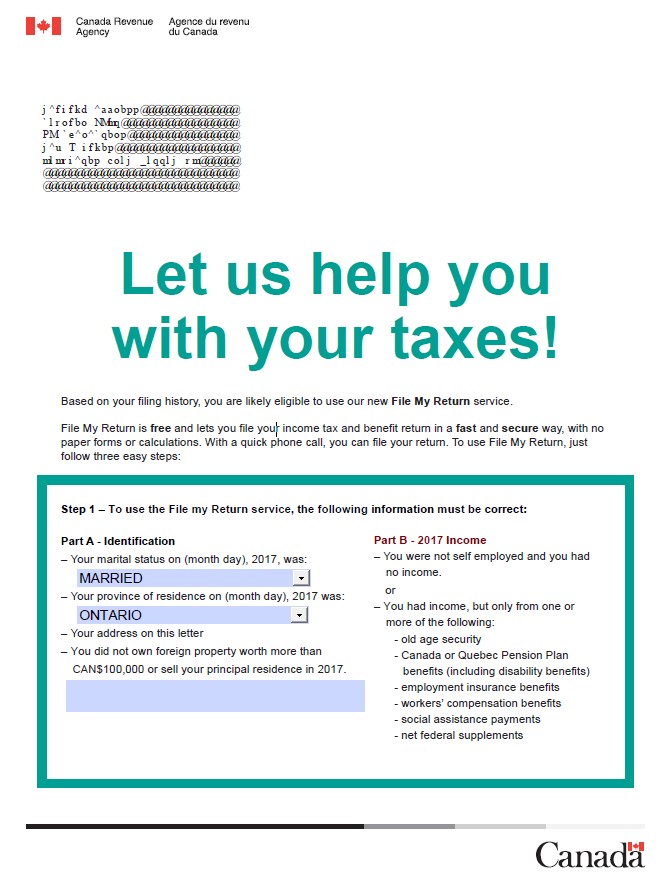
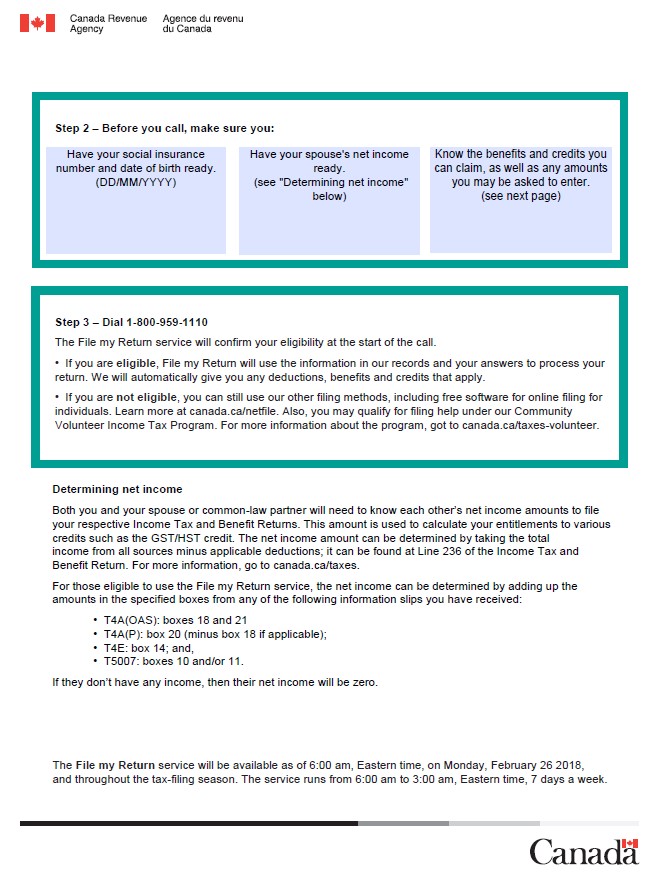
Single-Credits
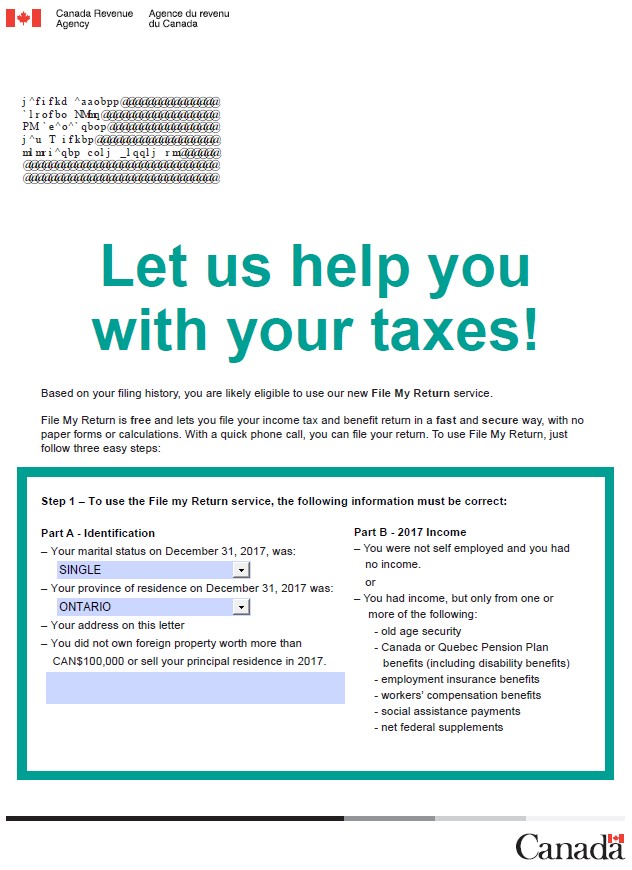

Married–No Credits (PQ)
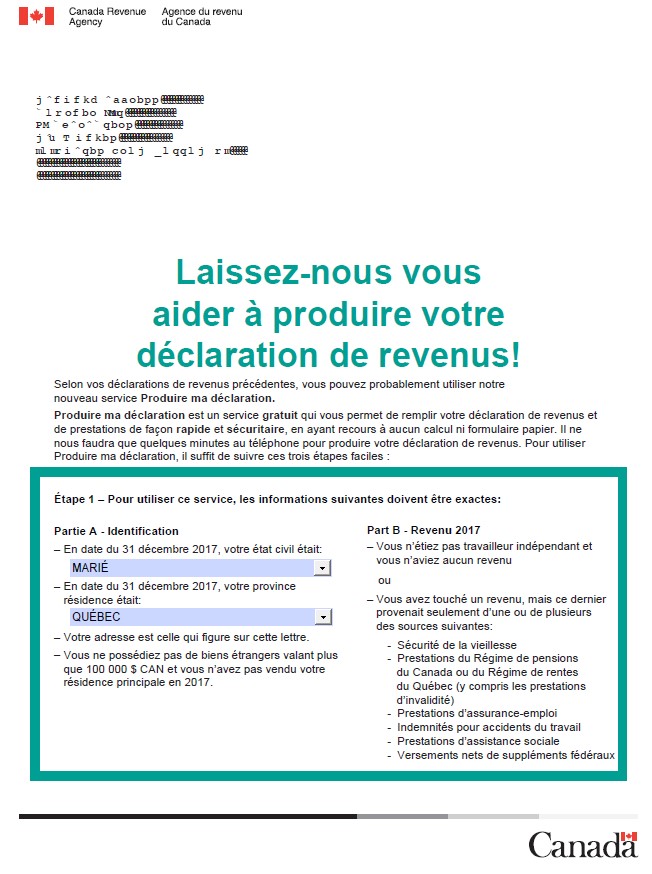
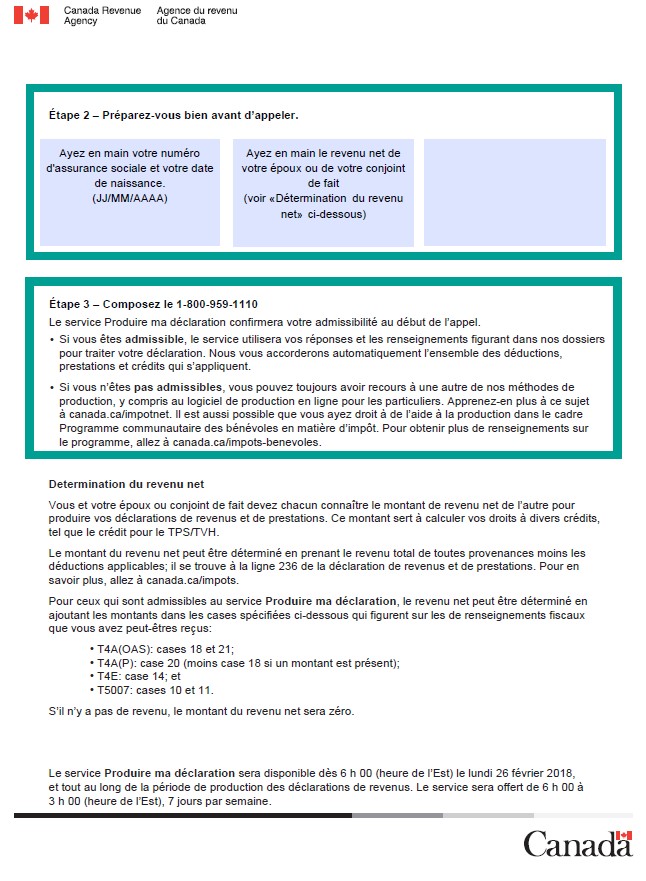
Single-No Credits (PQ)
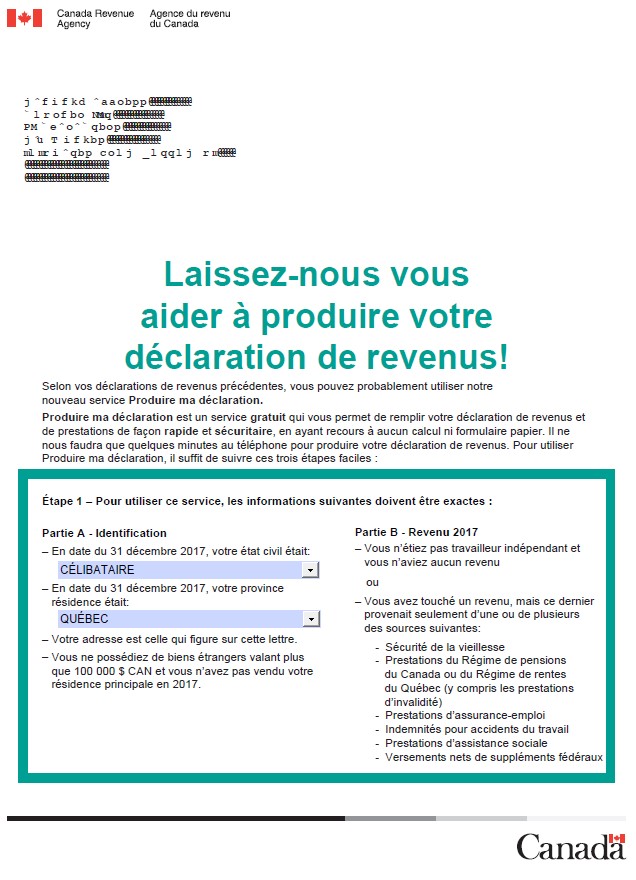
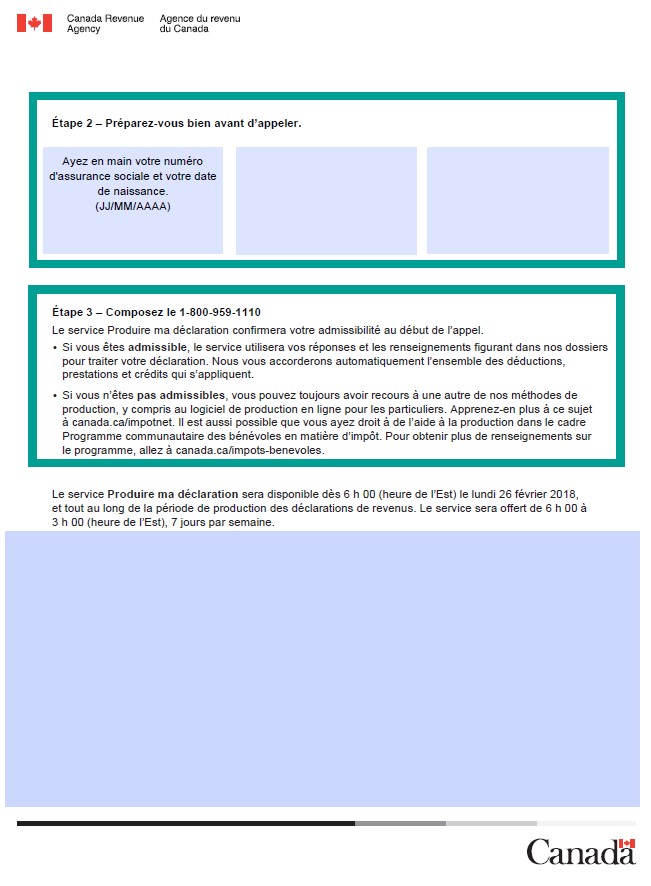
Info Sheet–Ontario

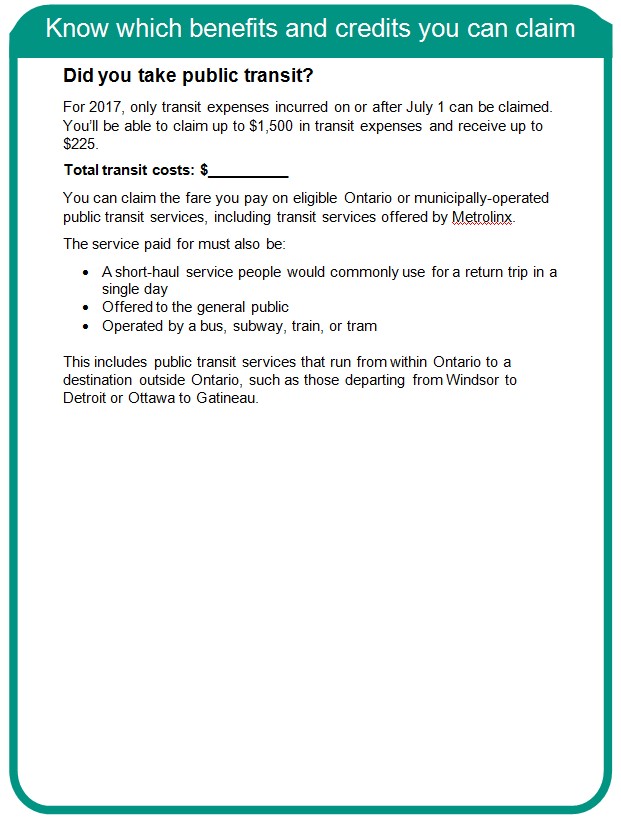
Info Sheet–New Brunswick

Info Sheet–Brirish Columbia (Single)

Info Sheet–British Columbia (Married)
